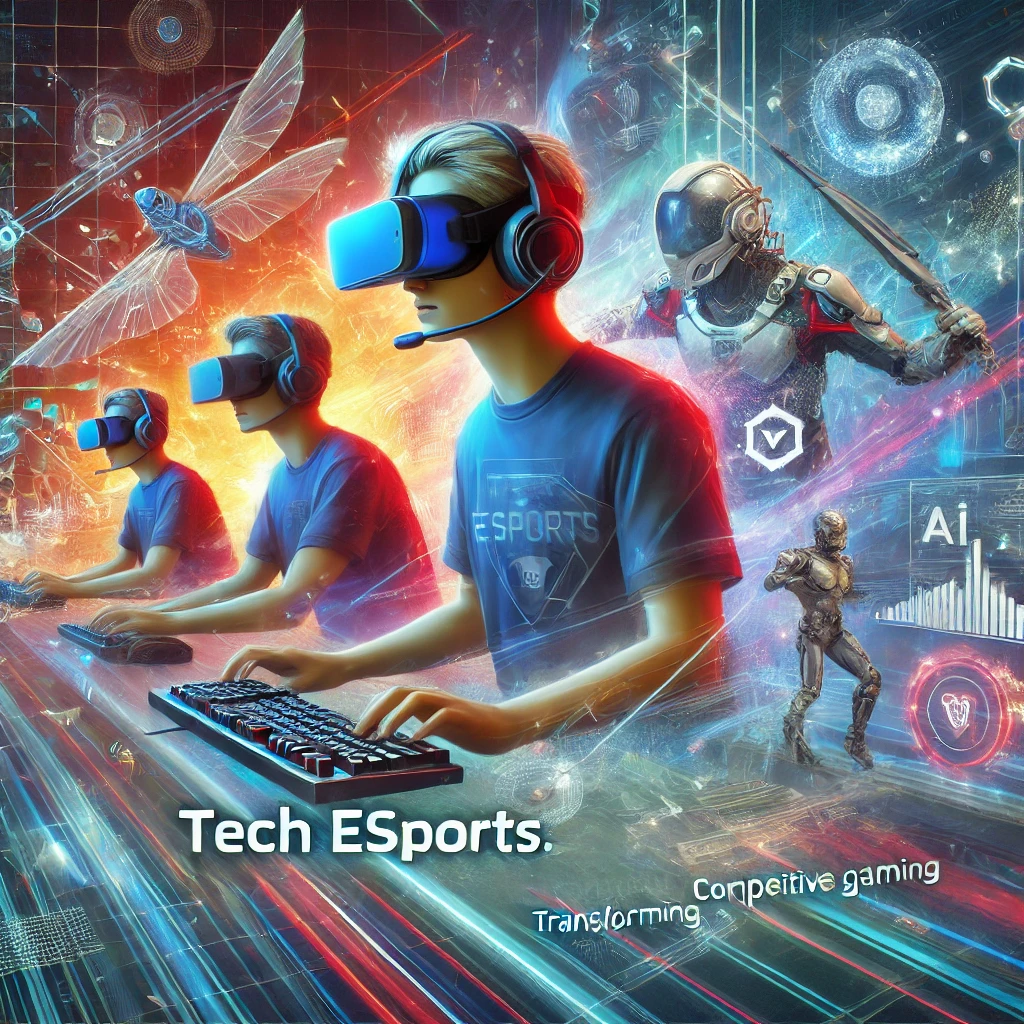
The world of eSports has seen a remarkable transformation over the years, driven by rapid technological advancements. From humble beginnings with basic setups, eSports has evolved into a global phenomenon. This article explores the pivotal technologies that have shaped the industry, offering a glimpse into the innovations that continue to redefine competitive gaming. As we journey through the evolution of eSports technology, discover how these advancements enhance player performance, revolutionize spectator experiences, and pave the way for future trends. Let’s delve into the technological milestones that have made eSports what it is today.
Development of Online Multiplayer Platforms
The evolution of online multiplayer platforms has revolutionized the eSports industry, allowing players from around the world to connect and compete in real-time. This development has been a game-changer, transforming casual gaming into a highly competitive and professional arena.
Evolution of Internet and Connectivity
The rise of high-speed internet has been fundamental to the growth of online multiplayer gaming. Early online games were limited by dial-up connections, which offered slow speeds and high latency. As broadband internet became widely available, it provided the necessary bandwidth and reduced latency, enabling smoother and more reliable online gaming experiences. This improvement in connectivity laid the groundwork for the proliferation of online multiplayer games and eSports competitions.
Major Platforms and Their Impact
Several key platforms have played a significant role in the development of online multiplayer gaming.
- Battle.net (Blizzard Entertainment): Launched in 1996, Battle.net was one of the first online gaming services integrated into popular games like Diablo, StarCraft, and Warcraft. It provided a seamless multiplayer experience and established a standard for future online gaming platforms.
- Xbox Live (Microsoft): Introduced in 2002, Xbox Live revolutionized console gaming by offering an online multiplayer service that included matchmaking, leaderboards, and digital content distribution. It brought competitive gaming to a broader audience and fostered a thriving online community.
- Steam (Valve Corporation): Since its launch in 2003, Steam has become the leading digital distribution platform for PC gaming. Steam’s community features, including chat, groups, and user-generated content, have fostered a vibrant online gaming environment. Its robust multiplayer support has been crucial for the success of many eSports titles.
- PlayStation Network (Sony): Similar to Xbox Live, the PlayStation Network (PSN) has provided an extensive online gaming service for PlayStation users since 2006. PSN’s integration with popular games and its online multiplayer capabilities have been significant for console-based eSports.
- Riot Games and League of Legends: Launched in 2009, League of Legends (LoL) quickly became a cornerstone of the eSports industry. Riot Games’ dedicated servers and robust online infrastructure have allowed millions of players to compete globally, making LoL one of the most popular eSports titles.
- Epic Games and Fortnite: Fortnite’s release in 2017 marked a new era in online multiplayer gaming. Its battle royale mode, coupled with cross-platform play, attracted a massive player base. Epic Games’ continuous updates and events have kept the community engaged, solidifying Fortnite’s place in eSports.
Impact on eSports
The development of these online multiplayer platforms has had a profound impact on the eSports landscape. They have provided the infrastructure needed for large-scale tournaments and leagues, enabling players to compete professionally. The ability to host online competitions has expanded the reach of eSports, allowing players from different regions to participate without the need for physical travel. This inclusivity has contributed to the global popularity of eSports.
Additionally, these platforms have facilitated the growth of eSports communities, where players can share strategies, watch live streams, and engage with their favorite games. Social features such as chat rooms, forums, and user-generated content have created a sense of belonging and camaraderie among players.
Advances in Gaming Hardware and Peripherals
Advancements in gaming hardware and peripherals have played a pivotal role in the evolution of eSports, enhancing both player performance and the overall gaming experience. From powerful gaming rigs to specialized accessories, these innovations have significantly contributed to the professionalization of competitive gaming.

Hardware Innovations
Gaming Consoles and PCs
The development of high-performance gaming consoles and PCs has been fundamental to the rise of eSports. Modern gaming consoles like the PlayStation 5 and Xbox Series X offer impressive processing power, high-resolution graphics, and fast load times, providing a seamless gaming experience. Similarly, gaming PCs equipped with cutting-edge GPUs, high-speed processors, and large amounts of RAM deliver the performance required for competitive play.
Graphics Processing Units (GPUs)
GPUs have undergone significant advancements, enabling the rendering of realistic and detailed graphics. Companies like NVIDIA and AMD have continuously pushed the boundaries with their latest GPUs, providing the necessary power for high-definition gaming. These advancements allow players to experience games at higher frame rates and resolutions, giving them an edge in competitive scenarios.
Monitors and Displays
The quality of monitors and displays has seen remarkable improvements. High refresh rate monitors (120Hz, 144Hz, and even 240Hz) reduce motion blur and provide smoother visuals, crucial for fast-paced games. Additionally, advancements in display technology, such as 4K resolution and HDR, offer more vibrant and lifelike images, enhancing the gaming experience.
Enhancing Player Performance with Advanced Peripherals
Gaming Mice and Keyboards
Precision and responsiveness are key factors in competitive gaming. Modern gaming mice are equipped with high-DPI sensors, customizable buttons, and ergonomic designs, allowing for greater accuracy and comfort. Mechanical keyboards with tactile switches provide faster response times and better feedback, enabling players to execute commands with minimal delay.
Headsets and Audio Equipment
Clear communication and immersive sound are essential in eSports. High-quality gaming headsets with surround sound capabilities and noise-canceling features allow players to hear in-game audio cues and communicate effectively with teammates. This enhances situational awareness and teamwork, which are critical in competitive matches.
Controllers and Gamepads
For console players, the design and functionality of controllers are vital. Modern controllers offer features like haptic feedback, adaptive triggers, and customizable buttons, providing a more intuitive and immersive gaming experience. These enhancements help players maintain control and precision during intense gameplay.
VR and AR Equipment
Virtual Reality (VR) and Augmented Reality (AR) peripherals are beginning to make their mark in eSports. VR headsets and motion controllers offer an immersive gaming experience, bringing a new dimension to competitive play. AR technology, while still in its early stages, has the potential to overlay digital information onto the real world, providing new ways to engage with games.
Software Solutions and Their Impact on eSports
Software solutions have been integral to the growth and development of the eSports industry. From game development platforms to tools that enhance player performance and audience engagement, software has shaped how eSports are played, watched, and managed.
Game Development and Platforms
Game Engines
The evolution of game engines such as Unreal Engine and Unity has revolutionized the way games are created. These powerful tools allow developers to design and build complex game worlds with high-quality graphics and physics. Their flexibility and capabilities have led to the development of many popular eSports titles, offering both stunning visuals and smooth gameplay.
Matchmaking Systems
Efficient matchmaking systems are essential for competitive play. Advanced algorithms pair players of similar skill levels, ensuring fair and balanced matches. This has improved the overall player experience, reducing frustration and fostering a more competitive environment. Games like League of Legends and Overwatch have implemented sophisticated matchmaking systems to maintain competitive integrity.
Software Enhancements for Better Gaming Experience
Anti-Cheat Software
Maintaining fairness in competitive gaming is paramount. Anti-cheat software detects and prevents cheating, ensuring that all players compete on a level playing field. Solutions like Valve Anti-Cheat (VAC) and Riot’s Vanguard system monitor gameplay for suspicious activity, helping to preserve the integrity of eSports competitions.
Game Analytics Tools
Data analytics tools have become crucial for both players and teams. These tools analyze gameplay data to provide insights into player performance, strategies, and weaknesses. Software like Mobalytics and Blitz.gg offer detailed breakdowns of in-game actions, helping players improve their skills and teams refine their tactics.
Voice Communication Platforms
Effective communication is vital in team-based eSports. Voice communication platforms like Discord and TeamSpeak provide reliable and low-latency communication channels, allowing teams to coordinate strategies and react quickly during matches. These platforms also offer community-building features, enhancing the social aspect of gaming.
Influence on Viewer Experience and Industry Growth
Streaming Platforms
The rise of streaming platforms like Twitch and YouTube Gaming has transformed how eSports are consumed. These platforms allow fans to watch live games, interact with streamers, and participate in communities. Features such as live chat, emotes, and subscription models have created engaging and interactive viewing experiences.
Spectator Tools
Spectator tools within games have improved how audiences experience live matches. Features like dynamic camera angles, instant replays, and in-game statistics provide viewers with a comprehensive understanding of the action. Games like Dota 2 and Counter-Strike: Global Offensive have developed robust spectator modes, making the viewing experience more immersive.
Broadcast Software
Professional broadcasts of eSports events rely on advanced broadcast software. Tools like OBS (Open Broadcaster Software) and XSplit enable high-quality live streaming, with features such as overlays, alerts, and multi-stream capabilities. These tools help create polished and engaging broadcasts, similar to traditional sports events.
Streaming and Broadcasting Technologies
Streaming and broadcasting technologies have transformed eSports from a niche activity into a mainstream entertainment phenomenon. These advancements have made it possible for millions of viewers around the world to watch live eSports events, engage with their favorite players, and participate in vibrant online communities.
Evolution of Streaming Platforms
Twitch
Twitch, launched in 2011, has become the leading platform for live streaming eSports. It offers a dedicated space for gamers to broadcast their gameplay, interact with viewers, and build communities. Twitch’s interactive features, such as live chat, emotes, and subscriptions, have revolutionized how audiences engage with eSports content.
YouTube Gaming
YouTube Gaming, launched in 2015, has provided a robust alternative to Twitch. Leveraging YouTube’s massive user base, it offers live streaming, video-on-demand, and community engagement features. The platform supports a wide range of eSports content, from live tournaments to highlight reels and tutorial videos.
Facebook Gaming and Other Platforms
Facebook Gaming and other emerging platforms like Mixer (now defunct) and Trovo have also contributed to the diversity of eSports streaming. These platforms offer unique features and attract different audience demographics, further expanding the reach of eSports.
Influence on Viewer Experience
Interactive Features
Modern streaming platforms offer various interactive features that enhance the viewer experience. Live chat allows fans to interact with streamers and other viewers in real-time, creating a sense of community. Subscription services and donations support streamers financially, while custom emotes and badges offer ways for viewers to express themselves.
Enhanced Viewing Options
Streaming platforms provide enhanced viewing options, such as multiple camera angles, instant replays, and detailed player statistics. These features allow viewers to follow the action closely and gain a deeper understanding of the game. For example, platforms like Twitch and YouTube Gaming offer tools for streamers to overlay information, polls, and alerts, making the broadcast more engaging.
Mobile Accessibility
The ability to watch streams on mobile devices has increased the accessibility of eSports. Apps for Twitch, YouTube Gaming, and other platforms allow fans to watch live events and recorded content anywhere, anytime. This accessibility has contributed to the growing popularity of eSports across different age groups and regions.
Professional Broadcasting Software
OBS Studio
Open Broadcaster Software (OBS) Studio is one of the most widely used tools for live streaming. It offers a range of features, including customizable scenes, multiple source inputs, and real-time video and audio mixing. OBS Studio is open-source and free, making it accessible to both amateur and professional streamers.
XSplit
XSplit is another popular broadcasting software that provides advanced streaming capabilities. It offers features like scene transitions, multi-stream support, and integration with various streaming platforms. XSplit’s user-friendly interface and robust functionality make it a favorite among many professional eSports broadcasters.
Streamlabs
Streamlabs is a comprehensive streaming tool that integrates with OBS to offer additional features such as donation management, custom alerts, and chatbot functionalities. Streamlabs simplifies the streaming setup process and enhances the overall production quality of eSports broadcasts.
Impact on Industry Growth
Audience Reach
Streaming and broadcasting technologies have significantly expanded the audience reach of eSports. Major tournaments and events are now watched by millions of viewers worldwide, attracting sponsorships and advertising revenue. This global audience has made eSports a lucrative industry, comparable to traditional sports.
Community Building
These technologies have also fostered strong online communities. Streamers and content creators build loyal fan bases, engage directly with their audience, and create content that resonates with their viewers. This community-driven approach has been a key factor in the sustained growth and popularity of eSports.
Monetization
Streaming platforms offer various monetization options for both individual streamers and professional organizations. Revenue streams include subscriptions, donations, advertisements, and sponsorships. Successful streamers and eSports organizations leverage these opportunities to generate significant income, further professionalizing the industry.
Virtual Reality (VR) and Augmented Reality (AR) in eSports
Virtual Reality (VR) and Augmented Reality (AR) are pushing the boundaries of the eSports industry, creating immersive and interactive experiences for both players and spectators. These technologies are transforming how games are played, viewed, and experienced, offering a new dimension to competitive gaming.

Integration and Applications in Gaming
Virtual Reality (VR)
VR technology immerses players in a fully digital environment, providing a 360-degree field of view and interactive experiences. VR headsets like the Oculus Rift, HTC Vive, and PlayStation VR transport players into the game world, allowing them to interact with the environment and other players in ways that traditional gaming setups cannot.
- Immersive Gameplay: VR enables players to experience games from a first-person perspective, enhancing the sense of presence and immersion. This is particularly impactful in games that rely on a strong sense of spatial awareness and physical interaction.
- Training Simulations: VR is used for training simulations in eSports, helping players to practice and improve their skills in a controlled environment. These simulations can replicate real-game scenarios, providing valuable practice without the consequences of actual gameplay.
Augmented Reality (AR)
AR overlays digital information onto the real world, enhancing the gaming experience without completely removing players from their physical surroundings. Devices like Microsoft HoloLens and mobile AR applications bring game elements into the player’s environment.
- Enhanced Spectator Experience: AR can enhance live eSports events by overlaying game stats, player information, and interactive elements onto the real-world venue. Spectators can view these augmented elements through their smartphones or AR glasses, making the viewing experience more engaging and informative.
- Interactive Gameplay: AR can create hybrid experiences where physical and digital elements interact. For example, AR games can project game elements onto a physical table, allowing players to interact with both the real and virtual components of the game.
Enhancing Spectator and Player Experience
Spectator Experience
- Live Events: VR and AR technologies can transform live eSports events into highly interactive experiences. VR headsets can give spectators a first-person view of the game, allowing them to experience the action from the perspective of their favorite players. AR can provide real-time stats and interactive content during the event, enhancing the overall experience.
- Remote Viewing: VR platforms like Oculus Venues allow fans to watch eSports events in a virtual stadium, interacting with other spectators as if they were attending in person. This creates a sense of community and immersion for remote viewers.
Player Experience
- Immersive Training: VR offers unique training opportunities for players, allowing them to practice in highly realistic and customizable environments. This can help players refine their skills, strategies, and reflexes more effectively than traditional training methods.
- Physical Engagement: VR games often require physical movement, which can enhance the gaming experience by making it more active and engaging. This physical aspect can also contribute to better health and fitness for players.
Future Prospects of VR and AR in eSports
The future of VR and AR in eSports looks promising, with continuous advancements in technology and increasing adoption by both players and spectators.
- Technological Advancements: Improvements in VR and AR hardware, such as lighter and more comfortable headsets, higher resolution displays, and more accurate tracking systems, will enhance the overall experience. Software developments will also contribute to more immersive and interactive games.
- Broader Adoption: As VR and AR technology becomes more affordable and accessible, their adoption in eSports will likely increase. This will lead to a greater variety of VR and AR games and experiences, attracting more players and viewers.
- Innovative Applications: Future applications of VR and AR in eSports could include mixed reality tournaments, where players and spectators interact in both physical and digital environments, and new game genres specifically designed for these technologies.
Data Analytics and Artificial Intelligence in eSports
Data analytics and artificial intelligence (AI) have become pivotal in transforming the landscape of eSports. These technologies are not only enhancing player performance and strategy development but are also revolutionizing how games are managed and experienced.
Role in Player Performance and Strategy Development
Performance Analysis
Data analytics tools collect and analyze vast amounts of in-game data, offering detailed insights into player performance. Metrics such as reaction times, decision-making patterns, and accuracy rates can be scrutinized to identify strengths and areas for improvement. This data-driven approach enables players to refine their skills systematically.
Strategic Insights
Teams use data analytics to develop and fine-tune strategies. By analyzing opponents’ playstyles, tendencies, and weaknesses, teams can craft game plans tailored to exploit these insights. Tools like heatmaps and replay analysis provide visual representations of in-game actions, aiding in the strategic planning process.
Real-time Feedback
AI-driven analytics offer real-time feedback during matches, helping players and coaches make instant adjustments. This dynamic approach to strategy can significantly impact the outcome of matches, providing a competitive edge to teams that effectively utilize these technologies.
AI’s Impact on Game Development and Management
Game Balancing
AI plays a critical role in game development, particularly in balancing gameplay. Machine learning algorithms analyze player data to detect imbalances, such as overpowered characters or unfair advantages. Developers can then make informed adjustments, ensuring a fair and enjoyable gaming experience for all players.
Matchmaking Systems
AI-driven matchmaking systems enhance the gaming experience by pairing players of similar skill levels. These systems consider various factors, including player performance, win/loss ratios, and playstyles, to create balanced and competitive matches. This approach not only improves player satisfaction but also fosters a more competitive environment.
Anti-Cheat Measures
AI is instrumental in developing advanced anti-cheat systems. These systems use machine learning algorithms to detect unusual patterns of behavior indicative of cheating. By continuously learning and adapting, AI-driven anti-cheat solutions can effectively identify and mitigate cheating, preserving the integrity of eSports competitions.
Enhancing Viewer Experience
Predictive Analytics
Predictive analytics, powered by AI, can enhance the spectator experience by offering real-time predictions and insights. Viewers can access predictions about match outcomes, player performances, and in-game events, adding an extra layer of engagement to the viewing experience.
Automated Highlights
AI-driven tools can automatically generate highlights from live matches. By identifying key moments such as kills, objectives, and game-changing plays, these tools create highlight reels that capture the excitement of the match. This feature is particularly useful for fans who want to catch up on the action quickly.
Personalized Content
AI algorithms can curate personalized content for viewers based on their preferences and viewing history. This personalization enhances viewer engagement by delivering content that is most relevant and interesting to individual users, such as specific player streams, favorite game modes, or preferred teams.
Future Prospects
Advanced Training Programs
Future advancements in AI and data analytics will lead to the development of even more sophisticated training programs. Virtual coaches powered by AI could provide personalized training regimens, simulate various in-game scenarios, and offer tailored advice to help players improve their skills.
Enhanced Spectator Tools
As AI technology continues to evolve, we can expect more advanced spectator tools. These might include interactive features that allow viewers to manipulate in-game cameras, access detailed statistics, and participate in real-time polls or predictions during matches.
Comprehensive Game Management
AI will increasingly be integrated into every aspect of game management, from player recruitment and team formation to in-game decision-making and post-match analysis. This comprehensive integration will streamline operations, enhance performance, and ultimately contribute to the growth and professionalization of eSports.
Future Trends and Predictions in eSports Technology
The eSports industry continues to evolve rapidly, driven by technological advancements that shape its future. Emerging trends and innovations promise to transform competitive gaming, enhancing experiences for players, teams, and audiences. This section explores some of the most anticipated developments in eSports technology.

Emerging Technologies and Innovations
5G and Enhanced Connectivity
The rollout of 5G technology is set to revolutionize eSports by providing faster, more reliable internet connections. With reduced latency and higher bandwidth, 5G will enhance online gaming experiences, allowing for smoother gameplay and more seamless interactions. This technology will also support the development of mobile eSports, making high-quality competitive gaming accessible on smartphones and tablets.
Cloud Gaming
Cloud gaming platforms like Google Stadia, NVIDIA GeForce Now, and Microsoft’s xCloud are gaining traction. These services allow players to stream games directly to their devices without the need for high-end hardware. Cloud gaming can democratize access to eSports, enabling more people to participate in competitive gaming without significant financial investments in gaming rigs.
Blockchain and Cryptocurrency
Blockchain technology and cryptocurrency are beginning to impact the eSports ecosystem. Blockchain can ensure transparency in tournament operations, secure transactions, and provide a reliable way to verify player identities and statistics. Cryptocurrencies are also being adopted for prize payouts and in-game purchases, offering secure and instant transactions across borders.
Predictions for Future Growth and Market Trends
Expansion of Mobile eSports
Mobile gaming is already a massive segment of the gaming industry, and its influence on eSports is expected to grow. With the advent of 5G and more powerful mobile devices, mobile eSports titles like PUBG Mobile and Free Fire are gaining popularity. This trend will likely lead to more mobile-exclusive tournaments and a broader audience for mobile eSports.
Growth in Virtual and Augmented Reality eSports
As VR and AR technologies become more sophisticated and affordable, their integration into eSports will expand. These technologies offer immersive experiences that can attract new audiences and create innovative gameplay modes. Expect to see dedicated VR and AR eSports leagues and tournaments as these technologies mature.
AI and Machine Learning in Game Development
AI and machine learning will continue to influence game development, creating smarter NPCs, dynamic environments, and personalized gaming experiences. These advancements will result in more engaging and challenging games, which will enhance both casual and competitive play. AI-driven analytics will also improve player training and performance analysis, raising the overall skill level in eSports.
Market Trends and Economic Impact
Increasing Investment and Sponsorship
The eSports market is attracting significant investment from traditional sports teams, entertainment companies, and technology giants. This influx of capital is fueling the growth of eSports organizations, tournaments, and infrastructure. Sponsorship deals are becoming more lucrative, providing financial stability and promoting brand visibility within the eSports community.
Professionalization of eSports Organizations
As the industry matures, eSports organizations are adopting more structured and professional approaches. This includes improved player welfare, rigorous training programs, and strategic business operations. These developments are making eSports a viable career option and enhancing the overall quality of competition.
Global Expansion
eSports is experiencing rapid growth in regions such as Asia, Europe, and North America. Emerging markets in Latin America, Africa, and the Middle East are also starting to embrace competitive gaming. This global expansion is leading to a more diverse player base and audience, fostering cross-cultural interactions and broadening the appeal of eSports.
Tech eTrueSports: Impact and Future Prospects
Tech eTrueSports has emerged as a significant force in the eSports industry, introducing new technologies and methodologies that enhance player performance, revolutionize spectator experiences, and offer a competitive edge for teams. This section explores the impact of Tech eTrueSports on the eSports industry and its future prospects.
Definition and Importance
Tech eTrueSports refers to the application of advanced technologies and innovative solutions in the realm of eSports. These technologies include artificial intelligence, machine learning, data analytics, and virtual reality, among others. Tech eTrueSports aims to improve various aspects of eSports, from player training and performance to audience engagement and game management.
Current Applications and Innovations
Enhancing Player Performance
Tech eTrueSports has introduced numerous tools and applications designed to enhance player performance. These include:
- Wearable Technology: Devices that monitor physiological metrics such as heart rate, stress levels, and reaction times. This data helps players and coaches understand physical and mental states during gameplay, allowing for more effective training and performance optimization.
- Training Simulators: Advanced simulators that recreate in-game scenarios for practice. These tools use AI to adapt to player skill levels, providing personalized training sessions that improve specific skills.
- Data Analytics: Platforms that analyze gameplay data to offer insights into player performance, strategy, and decision-making. These analytics help players identify strengths and weaknesses, leading to more focused improvement efforts.
Revolutionizing Spectator Experience
Tech eTrueSports is also transforming how audiences experience eSports. Key innovations include:
- Interactive Streaming: Platforms that allow viewers to interact with live streams through features such as real-time stats, player perspectives, and interactive overlays. This makes watching eSports more engaging and informative.
- Augmented Reality (AR): AR technologies that enhance live events by overlaying digital information onto the physical environment. Spectators can use AR devices to see player stats, game progress, and other relevant information in real-time.
- Virtual Reality (VR) Spectating: VR headsets that provide an immersive viewing experience, allowing fans to watch games from within the virtual environment. This offers a unique and engaging way to experience eSports events.
Competitive Edge for Teams
Tech eTrueSports provides teams with a significant competitive advantage through various innovations:
- AI Coaching: Artificial intelligence systems that assist coaches in developing strategies and analyzing opponents. AI can process vast amounts of data to identify patterns and suggest tactics that human coaches might overlook.
- Performance Analytics: Detailed analytics that track player performance metrics over time. These analytics help teams make informed decisions about player development, team composition, and in-game strategies.
- Smart Infrastructure: Advanced gaming setups that include optimized hardware, high-speed internet connections, and state-of-the-art training facilities. These infrastructures support high-level performance and minimize technical issues during competitions.
Future Opportunities
The future of Tech eTrueSports holds numerous opportunities for growth and innovation:
- Expanded Use of AI: Further integration of AI in player training, game development, and tournament management. AI could offer even more personalized training programs and smarter in-game decision-making tools.
- Global Expansion: Increased adoption of Tech eTrueSports technologies worldwide, bringing advanced eSports solutions to emerging markets. This will help grow the global eSports community and increase competition levels.
- Sustainability Initiatives: Development of eco-friendly technologies and practices within the eSports industry. This includes energy-efficient hardware, sustainable event management, and initiatives to reduce the carbon footprint of eSports activities.
Conclusion
The eSports industry has experienced remarkable growth, driven by technological advancements that have redefined competitive gaming. From the evolution of online multiplayer platforms and advances in gaming hardware to the integration of VR, AR, AI, and data analytics, technology continues to enhance every aspect of eSports. Streaming and broadcasting innovations have transformed how audiences engage with eSports, while Tech eTrueSports provides tools that elevate player performance and offer strategic advantages for teams. As new technologies emerge and existing ones improve, eSports is set to reach even greater heights, creating exciting opportunities for players, fans, and industry stakeholders worldwide.
FAQs
1. What are the key technological advancements driving the growth of eSports?
High-speed internet connectivity, advanced gaming hardware, streaming and broadcasting technologies, virtual and augmented reality, and AI-driven analytics are major factors enhancing the eSports experience.
2. How has VR and AR impacted the eSports industry?
VR and AR have revolutionized eSports by providing immersive gameplay experiences and interactive spectator features, enhancing both player engagement and audience enjoyment.
3. What role does AI play in eSports?
AI enhances eSports through advanced matchmaking, performance analytics, training simulations, and anti-cheat systems, all contributing to a more competitive and fair gaming environment.
4. How do streaming platforms contribute to the growth of eSports?
Streaming platforms like Twitch and YouTube Gaming enable real-time interaction between players and viewers, broadening the audience base and increasing the visibility and popularity of eSports.
5. What is Tech eTrueSports and how does it benefit the eSports industry?
Tech eTrueSports integrates cutting-edge technologies such as AI, data analytics, and VR/AR to improve player performance, enhance viewer experiences, and provide strategic advantages for teams, driving the overall growth and professionalization of eSports.









